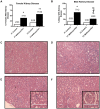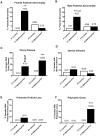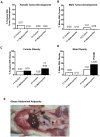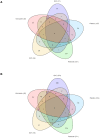Pesticide methoxychlor promotes the epigenetic transgenerational inheritance of adult-onset disease through the female germline
- PMID: 25057798
- PMCID: PMC4109920
- DOI: 10.1371/journal.pone.0102091
Pesticide methoxychlor promotes the epigenetic transgenerational inheritance of adult-onset disease through the female germline
Abstract
Environmental compounds including fungicides, plastics, pesticides, dioxin and hydrocarbons can promote the epigenetic transgenerational inheritance of adult-onset disease in future generation progeny following ancestral exposure during the critical period of fetal gonadal sex determination. This study examined the actions of the pesticide methoxychlor to promote the epigenetic transgenerational inheritance of adult-onset disease and associated differential DNA methylation regions (i.e. epimutations) in sperm. Gestating F0 generation female rats were transiently exposed to methoxychlor during fetal gonadal development (gestation days 8 to 14) and then adult-onset disease was evaluated in adult F1 and F3 (great-grand offspring) generation progeny for control (vehicle exposed) and methoxychlor lineage offspring. There were increases in the incidence of kidney disease, ovary disease, and obesity in the methoxychlor lineage animals. In females and males the incidence of disease increased in both the F1 and the F3 generations and the incidence of multiple disease increased in the F3 generation. There was increased disease incidence in F4 generation reverse outcross (female) offspring indicating disease transmission was primarily transmitted through the female germline. Analysis of the F3 generation sperm epigenome of the methoxychlor lineage males identified differentially DNA methylated regions (DMR) termed epimutations in a genome-wide gene promoters analysis. These epimutations were found to be methoxychlor exposure specific in comparison with other exposure specific sperm epimutation signatures. Observations indicate that the pesticide methoxychlor has the potential to promote the epigenetic transgenerational inheritance of disease and the sperm epimutations appear to provide exposure specific epigenetic biomarkers for transgenerational disease and ancestral environmental exposures.
Conflict of interest statement
Figures









Similar articles
-
Atrazine induced epigenetic transgenerational inheritance of disease, lean phenotype and sperm epimutation pathology biomarkers.PLoS One. 2017 Sep 20;12(9):e0184306. doi: 10.1371/journal.pone.0184306. eCollection 2017. PLoS One. 2017. PMID: 28931070 Free PMC article.
-
Plastics derived endocrine disruptors (BPA, DEHP and DBP) induce epigenetic transgenerational inheritance of obesity, reproductive disease and sperm epimutations.PLoS One. 2013;8(1):e55387. doi: 10.1371/journal.pone.0055387. Epub 2013 Jan 24. PLoS One. 2013. PMID: 23359474 Free PMC article.
-
Pesticide and insect repellent mixture (permethrin and DEET) induces epigenetic transgenerational inheritance of disease and sperm epimutations.Reprod Toxicol. 2012 Dec;34(4):708-19. doi: 10.1016/j.reprotox.2012.08.010. Epub 2012 Sep 11. Reprod Toxicol. 2012. PMID: 22975477 Free PMC article.
-
Epigenetic effects of methoxychlor and vinclozolin on male gametes.Vitam Horm. 2014;94:211-27. doi: 10.1016/B978-0-12-800095-3.00008-0. Vitam Horm. 2014. PMID: 24388192 Review.
-
Potential roles of noncoding RNAs in environmental epigenetic transgenerational inheritance.Mol Cell Endocrinol. 2014 Dec;398(1-2):24-30. doi: 10.1016/j.mce.2014.09.008. Epub 2014 Sep 16. Mol Cell Endocrinol. 2014. PMID: 25224488 Free PMC article. Review.
Cited by
-
Elusive inheritance: Transgenerational effects and epigenetic inheritance in human environmental disease.Prog Biophys Mol Biol. 2015 Jul;118(1-2):44-54. doi: 10.1016/j.pbiomolbio.2015.02.011. Epub 2015 Mar 16. Prog Biophys Mol Biol. 2015. PMID: 25792089 Free PMC article. Review.
-
Transgenerational sperm DNA methylation epimutation developmental origins following ancestral vinclozolin exposure.Epigenetics. 2019 Jul;14(7):721-739. doi: 10.1080/15592294.2019.1614417. Epub 2019 May 13. Epigenetics. 2019. PMID: 31079544 Free PMC article.
-
The effects of environmentally relevant concentrations of aldrin and methoxychlor on the testes and sperm of male Clarias gariepinus (Burchell, 1822) after short-term exposure.Fish Physiol Biochem. 2018 Dec;44(6):1421-1434. doi: 10.1007/s10695-018-0474-4. Epub 2018 Mar 9. Fish Physiol Biochem. 2018. PMID: 29520649
-
Epigenetic Regulation of Adipogenesis in Development of Metabolic Syndrome.Front Cell Dev Biol. 2021 Jan 12;8:619888. doi: 10.3389/fcell.2020.619888. eCollection 2020. Front Cell Dev Biol. 2021. PMID: 33511131 Free PMC article. Review.
-
'Omics' and endocrine-disrupting chemicals - new paths forward.Nat Rev Endocrinol. 2017 Dec;13(12):740-748. doi: 10.1038/nrendo.2017.81. Epub 2017 Jul 14. Nat Rev Endocrinol. 2017. PMID: 28707677 Free PMC article. Review.
References
Publication types
MeSH terms
Substances
Associated data
- Actions
Grants and funding
LinkOut - more resources
Full Text Sources
Other Literature Sources
Molecular Biology Databases
Miscellaneous

